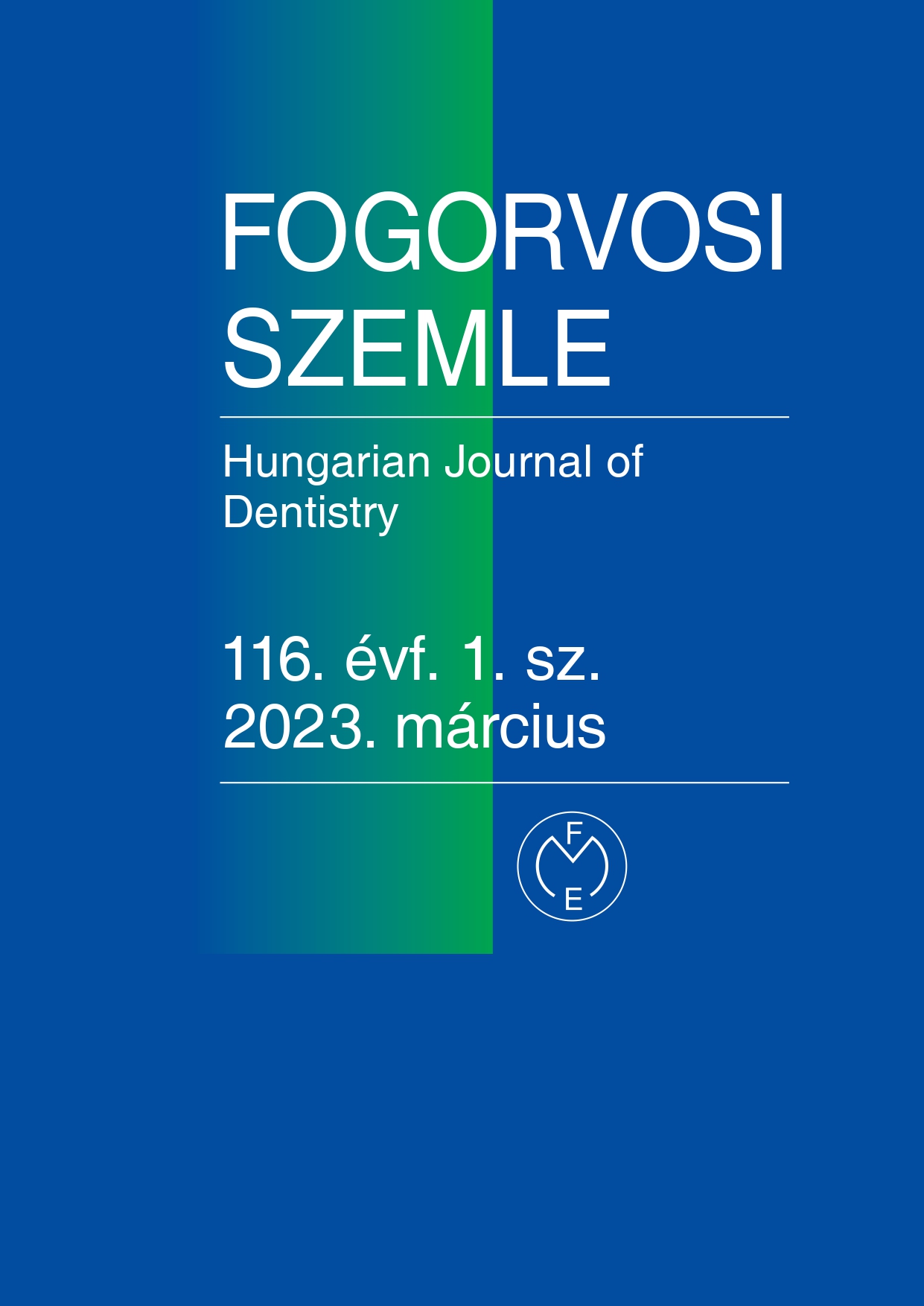Complex rehabilitation prosthetic care of a patient with maxilla and mandibular resection due to osteosarcoma
Abstract
In terms of deaths caused by oropharyngeal tumors, Hungary occupies a leading position not only in Europe, but also in the world. The “epidemic” spread of pharyngeal and oral cavity cancers peaked around the 2000s. Since then statistics show a decreasing tendency, but Hungary’s mortality rates are still among the highest among oropharingeal cancer patients, she treatment of head and neck tumors is very complex, wants a holistic cooperation between the experts of several specialties. Restoration after surgical resection in the area of the oral cavity is the task of a prosthodontist specialised for rehabilitation dental care.
Our female patient in the case report underwent a mandibular resection due to osteosarcoma at the age of 25 in 1997. Ten years later, she underwent a mandibular resection due to another, malignant bone tumor. In 2018, she again visited the Department of Prosthodontics, Faculty of Dentistry at Semmelweis University, where, after conservative dental treatments, a complex obturator prosthesis and a lower telescopic overdenture were made for her as part of a full mouth rehabilitation.
The interesting thing about the case is that the patient was diagnosed with cancer in the late 1990s, when the number of cancer cases and deaths in Hungary peaked. As is typical for osteosarcoma, the disease appeared at a young age, and thanks to the professional and timely treatment, she has been living his life free of relapses. Our patient has been under the care of the Prosthodontics Clinic of Semmelweis University for 25 years, and thanks to the professional rehabilitation prosthetic care, she wears a well-functioning prosthesis. Despite the somatic and psychological burdens, the patient, with excellent compliance throughout the treatments, is satisfied with her quality of life and lives a full life.
References
HERMANN P, KISPÉLYI B: Fogpótlástan. Semmelweis Kiadó, 2022; 957-1000.
FÁBIÁN T, GÖTZ GY, KAÁN M, SZABÓ I: A fogpótlástan alapjai. Semmelweis Kiadó 2001;
HERMANN P, SZENTPÉTERY A: Gnatológia. Semmelweis Kiadó 2018; 135-178.
GARAVELLO W., BERTUCCIO P., LEVI F., et al: The oral cancer epidemic in central and eastern Europe. Int J Cancer, 2010 Jul 1;127(1):160-71. https://doi.org/10.1002/ijc.25019
https://gco.iarc.fr/overtime/en 2022. 06. 24.
https://www.ksh.hu/stadat_files/nep/hu/nep0010.html 2022. 07. 19.
LA VECCHIA C., TAVANI A., FRANCESCHI S., et al.: Epidemiology and prevention of oral cancer. Oral Oncology, Volume 33, Issue5, 1997; 33: 302-312 https://doi.org/10.1016/S1368-8375(97)00029-8
LA VECCHIA C., BOSETTI C., GARAVELLO W., et al: Dietary factors and oral and pharyngeal cancer risk. Oral Oncology, 2009 Jun; 45(6):461-7. https://doi.org/10.1016/j.oraloncology.2008.09.002
NEWELL W. JOHNSON, HEMANTHA K. AMARASINGHE, JESSE R. QUALLIOTINE, et. al: Epidemiology. Oral Head and Neck Oncology and Reconstructive Surgery, 2018; Pages 2-56. https://doi.org/10.1016/B978-0-323-26568-3.00001-4
AMINI SHAKIB P., FOROUGHI R., SEYEDMAJIDI M.: Osteosarcoma of the Maxilla: A Rare Case with Unusual Clinical Presentation. J DEnt Res Dent Clin Dent Prospects, 2013; 7(3): 177-181. https://doi.org/10.5681/joddd.2013.029
FERNANDES R., NIKITAKIS NG., PAZOKI A. et al.: Osteogenic sarcoma of the jaw: a 10-year experience. J Oral Mxillofac Surg, 2007; 65(7):1286-91. https://doi.org/10.1016/j.joms.2006.10.030
KARTHIKEYAN I: A Review on Prosthetic Rehabilitation of Maxillofacial Region. Anaplastology, 2014; 3:1. https://doi.org/10.4172/2161-1173.1000125
HASSANEIN KA., MUSGROVE BT., BRADBURY E.; Psychological outcome of patients following treatment of oral cancer and its relation with functional status and coping mechanisms. J of Crani-Maxillofacial Surgery, 2005; V33, I6, Pages 404-409 https://doi.org/10.1016/j.jcms.2005.05.005
CARL W: Dental management and prosthetic rehabilitation of patients with head and neck cancer. Head Neck Surg., 1980; 3(1):27-42. https://doi.org/10.1002/hed.2890030108
SUBA Z., MIHALYI S., TAKACS D., et al.: Oral cancer: morbus Hungaricus in the 21st century. Fogorv Szle 2009 Apr; 102: 63-68.
LA VECCHIA C., LUCCHINI F., NEGRI E., et al: Trends in oral cancer mortality in Europe. Oral Oncol 2004; 40: 433-439. https://doi.org/10.1016/j.oraloncology.2003.09.013
https://onkol.hu/nemzeti-rakregiszter/ 2022. 07. 19.
LA VECCHIA C., BOSETTI C., GARAVELLO W., et al: Epidemiology of cancer with a focus on Europe. Int J Cancer, 2020; 147(4):1040-1049. https://doi.org/10.1002/ijc.32871
MACKENZIE J., AH-SEE K., SLOAN P., et al: Increasing incidence of oral cancer amongst young persons: what is the aetiology? Oral Onc, 2000; Volume 36, Issue 4, Pages 387-389 https://doi.org/10.1016/S1368-8375(00)00009-9
SZABÓ G: Szájsebészet, maxillofaciális sebészet. Semmelweis Kiadó, 2004; 149-183.
DIZ P., MELETI M., DINIZ-FREITAS M., et al: Oral and pharyngeal cancer in Europe: Incidence, mortality and trends as presented to the Global Oral Cancer Forum. Translational Research in Oral Oncology, 2017; Volume 2: 1–13 https://doi.org/10.1177/2057178X17701517
KÁSLER M., OTTÓ S., KENESSEY I: A rákmorbiditás és -mortalitás jelenlegi helyzete a Nemzeti Rákregiszter tükrében. Orvosi Hetilap, 2017; 158(3), 84–89.
Copyright (c) 2023 Authors

This work is licensed under a Creative Commons Attribution 4.0 International License.


.png)




1.png)



